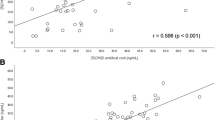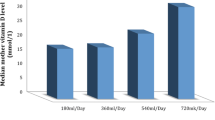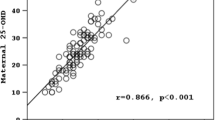Abstract
Adequate vitamin D status during pregnancy is crucial to assure normal fetal skeletal growth and to provide the vitamin D needed for infants’ stores. To determine the actual situation in Greece, we evaluated serum 25-hydroxyvitamin D (25[OH]D), calcium (Ca), phosphorus (P), alkaline phosphatase (ALP), parathyroid hormone (PTH), osteocalcin (OC), and calcitonin (CT) concentrations in 123 healthy mother-newborn pairs recruited from a public hospital of the sunny Athenian region. Blood samples were obtained from pregnant women at term and their neonates (cord blood). The study was conducted between June 2003 and May 2004. None of the mothers has been prescribed vitamin D supplements. Maternal 25(OH)D levels (16.4 [11-21.1] ng/mL) were significantly lower than umbilical venous blood concentrations (20.4 [13.9-30.4] ng/mL) (P < 0.001). A strong correlation was observed between maternal and infant 25(OH)D concentrations (r = 0.626, P < 0.001). Twenty-four (19.5%) mothers and 10 (8.1%) neonates had 25(OH)D <10 ng/mL. Pregnant women who delivered in summer and autumn reported higher levels of 25(OH)D (18.9 [12.9-23.3] ng/mL) than those who delivered in winter and spring (14.6 [10.1-18.5] ng/mL) (P = 0.006). Mothers with a darker phototype had lower levels of serum 25(OH) D than those with a fair phototype (P = 0.023). Umbilical venous blood Ca, P, OC, and CT levels were significantly higher than maternal venous blood levels (P < 0.001). PTH umbilical levels were lower than maternal levels (P < 0.001). Apparently, the abundant sunlight exposure in Athens is not sufficient to prevent hypovitaminosis D. Pregnant women should be prescribed vitamin D supplementations, and the scientific community should consider vitamin D supplementation of foods.


Similar content being viewed by others
References
Van der Wielen RPJ, Lowik MRH, van der Berg H, de Groot LCPGM, Haller J, Moreiras O, van Staveren WA (1995) Serum vitamin D concentrations among elderly people in Europe. Lancet 346:207–210
Ginat-Israeli T, Dranitzki Z, Straus U (2003) Nutritional rickets in infants immigrating to Israel from Ethiopia. Isr Med Assoc J 5:289–290
Ward L (2005) Vitamin D deficiency in the 21st century: a persistent problem among Canadian infants and mothers. CMAJ 172:769–770
Weisberg P, Scanlon KS, Li R, Cosgwell ME (2004) Nutritional rickets among children in the United States: review of cases reported between 1986 and 2003. Am J Clin Nutr 80:1697S–1705S
Hanley DA, Davison KS (2005) Vitamin D insufficiency in North America. J Nutr 135:332–337
Gannage-Yared MH, Chemali R, Yaacoub N, Halaby (2000) Hypovitaminosis D in a sunny country: relation to lifestyle and bone markers. J Bone Miner Res 15:1856–1862
DeLucia M, Carpenter T (2002) Rickets in the sunshine? Nutrition 8:97–98
Hollick MF (1995) Environmental factors that influence the cutaneous production of vitamin D. Am J Clin Nutr 61(suppl):638–645
Lapatsanis D, Moulas A, Cholevas V, Soukakos P, Papadopoulou ZL, Challa A (2005) Vitamin D: a necessity for children and adolescents in Greece. Calif Tissue Int 77:348–355
Bouillon R, Okamura WH, Norman AW (1995) Structure-function relationships in the vitamin D endocrine system. Endocr Rev 16:200–257
Haddad JG (1992) Vitamin D. Solar rays, the Milky Way or both. N Engl J Med 326:1213–1215
Holick MF (2003) Vitamin D: a millenium perspective. J Cell Bioch 88:296–307
Ladhani S, Srinivasan L, Buchanan C, Allgrove J (2004) Presentation of vitamin D deficiency. Arch Dis Child 89:781–784
Sachan A, Gupta R, Das V, Agarwal A, Awasthi PK, Bhatia V (2005) High prevalence of vitamin D deficiency among pregnant women and their newborns in northern India. Am J Clin Nutr 81:1060–1064
Care AD (1997) Vitamin D in pregnancy, the fetoplacental unit, and lactation. In: Feldman D, Glorieux FH, Wesley Pike J (eds). Vitamin D. New York: Academic Press, pp 437–443
Lawrence M, Garnter LM, Greer FR (2003) Section on Breastfeeding and Committee of Nutrition, American Academy of Pediatrics. Prevention of rickets and vitamin D deficiency: new guidelines for vitamin D intake. Pediatrics 111:908–910
Hollis BW, Wagner C (2004) Assessment of dietary vitamin D requirements during pregnancy and lactation. Am J Clin Nutr 79:717-726
Hill TR, O’Brien MM, Cashman KD, Flynn A, Kiely M (2004) Vitamin D intakes in 18?64-y-old Irish adults. Eur J Clin Nutr 58:1509-1517
Greer FR, Krebs NF, Committee on Nutrition (2006) Optimizing bone health and calcium intakes of infants, children, and adolescents. Pediatrics 117:578–585
Royal Society of Chemistry MAFF (1991) The Compositions of Foods, 5th ed. McCance and Widdowson, Turpin Distribution Services Ltd., Letchworth, Herts, SGG 1HN
Fitzpatrick TB (1975) Soleil et peau. J Med Esthet 2:33–34
Allgrove J (2004) Is nutritional rickets returning? Arch Dis Child 89:699–701
Ward L (2005) Vitamin D deficiency in the 21st century: a persistant problem among Canadian infants and mothers. CMAJ 172:769–768
Matsuoka LY, Worstman J, Haddad JG, Kolm P, Hollis BW (1991) Racial pigmentation and the cutaneous synthesis of vitamin D. Arch Dermatol 127:536–538
Lo C, Paris P, Holick M (1986) Indian and Pakistani immigrants have the same capacity as Caucasians to produce vitamin D in response to ultraviolet irradiation. Am J Clin Nutr 44:683–685
Stamp TCB, Round JM (1974) Seasonal changes in human plasma levels of 25-hydroxyvitamin D. Nature 247:563–565
Institute of Medicine Food and Nutrition Board, Standing Committee on the Scientific Evaluation of Dietary Reference Intakes Vitamin D (1997) In: Dietary reference intakes for calcium, phosphorous, magnesium, vitamin D and fluoride. National Academy Press, Washington DC, pp 250–287
Salle B, Delvin E, Lapillonne A, Bishop N, Glorieux F (2000) Perinatal metabolism of vitamin D. Am J Clin Nutr 71:1317S–1324S
Stearns G, Jeans PC, Vandecar V (1936) The effect of vitamin D on linear growth in infancy. J Pediatr 9:1–10
Thomson K. Morley R, Grover S, Zacharin M (2004) Postnatal evaluation of vitamin D and bone health in women who were vitamin D deficient in pregnancy and in their infants. MJA 181:486–488
Anatoliotaki M, Tsilimigaki A, Tsekoura T, Schinaki A, Stefanaki S, Nikolaidou P (2003) Congenital rickets due to maternal vitamin D deficiency in a sunny island of Greece. Acta Paediatr 92:389–391
Dawodu A, Agarwal M, Hossain M, Kochiyil J, Zayed R (2003) Hypovitaminosis D and vitamin D deficiency in exclusively breast-feeding infants and their mothers in summer: a justification of breast-feeding infants. J Pediatr 142:169–173
Challa A, Ntourntoufi A, Cholevas V, Bistori M, Galanakis E, Andronikou S (2005) Breastfeeding and vitamin D status in Greece during the first 6 months of life. Eur J Pediatr 164:724–729
Craig M, Bowyer L, Doyle E, Catting-Paull C, Diamond T, Srinivasan S, Homer C (2005) Vitamin D and calcium status in a population of pregnant women and neonates. Horm Res 64(suppl 1):93
Hsu S, Levine M (2004) Perinatal calcium metabolism: physiology and pathophysiology. Semin Neonatol 9:23–36
Ardawi S, Nasrat H, BA’Aqueel H (1997) Calcium regulating hormones and parathyroid hormone related peptide in normal pregnancy and postpartum: a longitudinal study. Eur J Endocrinol 137:402–409
Wieland P, Fischer JA, Trechsel U, Roth HR, Vetter K, Schneider H, Huch A (1980) Perinatal parathyroid hormone, vitamin D metabolites, and calcitonin in man. Am J Physiol Endocrinol Metab 239:E385–E390
Kato T, Seki K, Matsui H, Sekiya S (1998) Monomeric calcitonin in pregnant women and in cord blood. Obstet Gynecol 92:241–244
Seki K, Makimura N, Mitsui C, Nagata I (1993) Osteocalcin levels in maternal and cord blood. Obstet Gynecol 81:189–190
Alatas O, Colak O, Alatas E, Tekin B, Inal M, Ozalp S (1995) Osteocalcin metabolism in late fetal life: fetal and maternal osteocalcin levels. Clin Chim Acta 239:179–183
Acknowledgment
We are grateful to Nestle, Hellas SA, for the financial support of this study. We also thank Dr. Basil Psiloglou at the National Observatory of Athens for giving us the data on global radiation in Athens during the study period.
Author information
Authors and Affiliations
Corresponding author
Rights and permissions
About this article
Cite this article
Nicolaidou, P., Hatzistamatiou, Z., Papadopoulou, A. et al. Low Vitamin D Status in Mother-Newborn Pairs in Greece. Calcif Tissue Int 78, 337–342 (2006). https://doi.org/10.1007/s00223-006-0007-5
Received:
Accepted:
Published:
Issue Date:
DOI: https://doi.org/10.1007/s00223-006-0007-5




